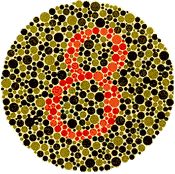The complete inability to see color, known as color blindness, is a well known phenomenon to many people. Although total color blindness is a very rare condition, it is part of a larger family of conditions known as Color Vision Deficiency, which is actually quite common.

Color Vision Deficiency entails the inability of the eye to tell the difference between different shades of color. It is the more severe cases of this disorder, in which the eye is completely unable to discern any color at all, that is commonly referred to as color blindness.
Short of total color blindness, two main types of Color Vision Deficiency exist, Red-Green (which is the most common form), and Blue-Yellow.
Many people don’t realize exactly how difficult this condition can make life for those who suffer from it. The inability to differentiate from red and green makes it impossible to know when to stop or go when at a traffic light. People are often described by reference to the color of the clothes they wear, driving and walking directions are often given in terms of colored land marks it is quite common to receive color-based instructions on how to complete important activities. An inability to discern certain colors can, therefore, cause serious errors that lead to frustration at best and personal danger or harm at worst.
 Despite these challenges, however, there is hope. Special corrective lenses can be prescribed by your doctor to help compensate for the missing color filters in your eyes. This is called Color Vision Correction. Although it will not give you perfect color vision, it will allow you to see more colors and shades of colors, and can make colors more vivid and distinct, making these colors more easily recognizable to you.
Despite these challenges, however, there is hope. Special corrective lenses can be prescribed by your doctor to help compensate for the missing color filters in your eyes. This is called Color Vision Correction. Although it will not give you perfect color vision, it will allow you to see more colors and shades of colors, and can make colors more vivid and distinct, making these colors more easily recognizable to you.
If you have questions about color vision deficiency or any of our eye care services, call our South St. Louis optometrist clinic today!
We also offer Latisse for thicker eyelashes.


